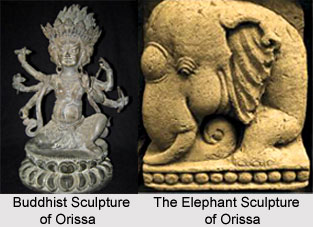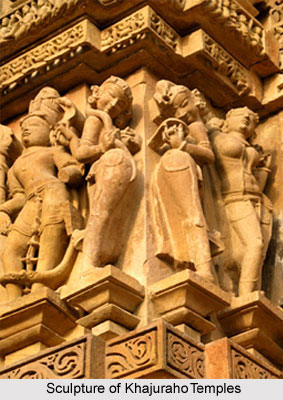About Badami Chalukya Sculptures
 Badami Chalukya sculptures closely resembled the Dravidian architecture. This kind of sculpture evolved in the 5th century and continued till the 8th century. Two kinds of monuments developed under the Badami Chalukyas: rock-cut temples and structural temples. The features of Badami Chalukya sculpture include intricate stone works and outstanding figurines. Soapstone was widely used as the building material. Columned halls, pillared verandahs and `garbhagrihas` are the main architectural elements of the Badami Chalukyas. Narasobba, Revadi Ovajja and Anivaritachari were some of the most reputed sculptors during the age of the Badami Chalukyas. Structural temples and rock-cut halls are two of the celebrated types of architectural wonders prevalent during that point of time. The Badami Chalukya style of sculpture is a brilliant fusion of the Dravidian or southern Indian styles and Indo-Aryan Nagara styles of architecture. The style is said to have evolved during the 5th and the 8th centuries.
Badami Chalukya sculptures closely resembled the Dravidian architecture. This kind of sculpture evolved in the 5th century and continued till the 8th century. Two kinds of monuments developed under the Badami Chalukyas: rock-cut temples and structural temples. The features of Badami Chalukya sculpture include intricate stone works and outstanding figurines. Soapstone was widely used as the building material. Columned halls, pillared verandahs and `garbhagrihas` are the main architectural elements of the Badami Chalukyas. Narasobba, Revadi Ovajja and Anivaritachari were some of the most reputed sculptors during the age of the Badami Chalukyas. Structural temples and rock-cut halls are two of the celebrated types of architectural wonders prevalent during that point of time. The Badami Chalukya style of sculpture is a brilliant fusion of the Dravidian or southern Indian styles and Indo-Aryan Nagara styles of architecture. The style is said to have evolved during the 5th and the 8th centuries.
There are numerous temples that bear testimony to the splendour of the sculptures belonging to the reign of the Badami Chalukya Dynasty, particularly the renowned Badami Cave Temples which are equipped with a sanctum carved into a rock, columned hall and a pillared verandah space.
 The most impressive feature of such temples is the presence of running frieze of `Ganas`, which portray interesting postures of deities embedded alongside the relief plinths. Experimentation in the field of idol sculpting has been attempted in the rock-cut halls, which include Jain, Vedic and Buddhist forms of architecture. Though the external verandahs of the Badami Cave Temples are devoid of sculptures, its inner halls are richly embellished with exquisite sculptural symbolism.
The most impressive feature of such temples is the presence of running frieze of `Ganas`, which portray interesting postures of deities embedded alongside the relief plinths. Experimentation in the field of idol sculpting has been attempted in the rock-cut halls, which include Jain, Vedic and Buddhist forms of architecture. Though the external verandahs of the Badami Cave Temples are devoid of sculptures, its inner halls are richly embellished with exquisite sculptural symbolism.
The temples of Pattadakal, six of which boast of Dravidian architecture are also attractive instances of Badami Chalukya sculptures. Four other Pattadakal temples have been built in the Rekhanagara style. Virupaksha Temple`s architecture resembles that of the Kailasantha Temple in Kanchipuram and its sculptures are quite unique. Pilasters have been employed to divide the outer wall surface which are adorned with perforated windows or even elaborate sculptures. The sculpture of the Shiva-Parvati posture is one of the most outstanding sculptural specimens of the Badami Chalukya era. Much later, these sculptures were introduced in the pillars which were erected during the rule of the kings of Vijayanagara Empire. The caves belonging to this particular time period possess finely carved out sculptures of `Gomateshvara`, `Harihara`, `Mahisa Mardhini`, `Tandavamurthi`, `Nataraja`, `Paravasudeva`, `Varaha`, `Trivikrama` and several others. Motifs of foliages and those of animals have also been embedded in such sculptures.
Sculptures of Badami Chalukyas are quite famous and include those observed inside the premises of Sangameswarar Temple and numerable others located in Aihole, Badami, Pattadakal, Gerusoppa and Alampur in the state of Andhra Pradesh. Mahakuteshwara Temple, Papanatha Temple, Galganatha Temple, Kashivisvanatha Temple, Mallikarjuna Temple which are all in Pattadakal, Lad Khan Temple and Durga Temple in Aihole, Bhutanatha Group of Temples and the four Cave Temples in Badami, Alampur Navabrahma Temples and Vardhamanaswamy Temple at Gerusoppa are amongst the innumerable temples which are decorated with different artistic forms of sculptures and architectural marvels.
Features Of Badami Chalukya Sculpture
 During the 5th to 8th centuries the Badami Chalukya sculpture evolved. The features of Badami Chalukya sculpture were differed in style from the previous kingdoms. The detailed sculptures were primarily found on the temples. The Chalukya kingdom was based in the area of Malaprabha basin (Bagalkot district, Karnataka). The style of Chalukyan sculpture is also known as Vesara style. The Chalukyas mainly built two kinds of monuments: rock cut halls or caves and structural temples.
During the 5th to 8th centuries the Badami Chalukya sculpture evolved. The features of Badami Chalukya sculpture were differed in style from the previous kingdoms. The detailed sculptures were primarily found on the temples. The Chalukya kingdom was based in the area of Malaprabha basin (Bagalkot district, Karnataka). The style of Chalukyan sculpture is also known as Vesara style. The Chalukyas mainly built two kinds of monuments: rock cut halls or caves and structural temples.
As far as cave temples are concerned, they have three basic features:
• Pillared Veranda
• Columned Hall
• A Rock Cut `garbhagriha`
These features of Badami Chalukya sculpture are apparent in the three caves of Aihole. These three caves are built in Vedic, Buddhist and Jain styles. However the later caves are built in the indigenous Badami style. The features of these Badami Chalukya sculpture is the running frescos of Ganas in different postures. These are found on each plinth of the caves. The sculpture of the outside verandah is simply done. But it is the inner hall that has been adorned with creative sculptural symbolism. The sculptures of the Badami Chalukyas reflect the versatility and the artistic wizardry of the era. Some of the best specimen of Badami Chalukya sculpture is to be found in Pattadakal temples. There are 10 temples at Pattadakal. Out of these six have been built in the Dravidian style and the rest four reflect the Rekhanagara style.
The sculptures of these temples have certain special features that distinguish them from other temples. Firstly these temples are fully inclusive. They have a central structure, Nandi pavilions in the front of the temple and there are gateways to enter the enclosed walls. Secondly, the architecture of the moan sanctum has a Pradakshinapatha and mandapa. The latter has pillars and window screens that are pierced. Lastly, the external walls of the temples are divided by pilasters. These niches are decorated with either well carved sculptures in Badami Chalukya style or with perforated windows.
One of the main features of Badami Chalukya sculpture is that there is a continuation; a spontaneity. The dedication with which these monuments were built has given way to several stories. It is said that in the Virupaskha temple the spirits who built it still reside.
Such was the influence of the Badami Chalukya sculpture that these reappeared in the architecture of the Vijayanagar monuments. Some of the famous sculptors in the Badami Chalukya Empire were Narasobba, Gundan Anivaritachari and Revadi Ovajja.



















